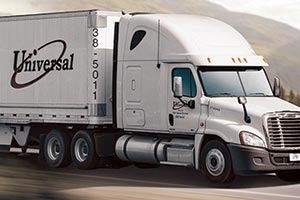TL Earnings Continue to Decline Amid High Capacity, Weak Pricing

This story appears in the May 8 print edition of Transport Topics.
The disappointing first quarter continued as three more truckload companies reported lower bottom-line results than a year ago, blaming the still-abundant capacity and a poor contract rate environment.
• Universal Logistics Holdings Inc. profits fell 42% year-over-year despite 9.2% growth in revenue during the same period, which the company acknowledged was due to problems with a few of its large value-added programs.
Net income was $4.3 million or 15 cents per share, matching the Bloomberg News consensus forecast of industry analysts. However, the numbers were $7.5 million or 26 cents one year ago.
Nevertheless, revenue increased to $284.4 million from $260.4 million a year ago, consisting of growth in the truckload, dedicated, intermodal, freight brokerage and value-added services divisions.
Company CEO Jeff Rogers expressed his excitement with the higher revenue but also was critical of the problems with higher expenses.
“We have many good things going on — especially the top-line growth we are experiencing as several of our business units are beginning to see recovery. Our challenge remains on the bottom line, where implementation cost and cost overruns continue to compress our margins in value-add,” he said on a call with industry analysts.
Loads were up in all divisions: 1.5% in truckload, 11% in brokerage, 2.7% in intermodal and 13% in dedicated.
For truckload services, overall load count was up 3.1% per day, due to increases in oil and gas loads and continued steady increases in overall flatbed loads, the company said. Revenue per mile, excluding fuel, was up 0.9%.
While the volume and revenue showed improvement year-over-year, the results were not as bright for the operating income — the amount after deducting expenses.
Companywide operating income dropped 34% to $9.2 million.
Universal Logistics Holdings, in Warren, Mich., ranks No. 30 on the Transport Topics Top 100 list of the largest U.S. and Canadian for-hire carriers.
• USA Truck lost $4.9 million in the first quarter, or 61 cents, worse than the 15-cents loss expected in a Bloomberg News survey of industry analysts.
One year ago, the carrier lost $1.8 million or 19 cents.
However, CEO James Reed told industry analysts that he intends to return the troubled company to profitability by the third quarter this year.
The Van Buren, Ark.-based company ranks No. 53 on the for-hire TT100.
“Having now completed three months in the role as USA Truck’s CEO, I believe we are making important strides toward improving our trucking segment’s productivity and taking the right steps in building a lean and efficient company that can generate profits in the relative near-term and create sustainable value over time,” Reed said.
Briefly the chief financial officer before succeeding Randy Rogers on Jan. 30, Reed has rolled out a five-point turnaround plan: bring in new leadership, cut fixed costs, transform the trucking division, improve weekly revenue per truck and increase net revenue in the brokerage division.
While the trucking division lost money, USAT Logistics generated $729,000 of income, but it still was a substantial fall from the $2 million profit in the year-ago period.
Reed said in an earnings call that the company has been making sequential gains since the second quarter of last year, especially in weekly revenue and miles driven per seated tractor. He also described a two-stage recovery process for the company, in getting pricing and performance first up to industry averages and then, through continued effort, beyond that.
• PAM Transport Inc. announced a 22% decline in profits to $2.3 million or 36 cents. One year ago, the numbers were $2.9 million or 41 cents.
Revenue increased 5.6% to $109.4 million for the first quarter of 2017, but excluding the fuel surcharges, it fell 0.04% to $93.6 million.
Expenses rose 8.9% to $106.7 million with higher rent and purchased transportation, depreciation and insurance and claims costs, the company said.
As a result, operating income dropped to $2.7 million from $5.6 million one year ago.
“The first quarter of 2017 was somewhat of a continuation of the trends we experienced in 2016, where we saw higher costs and downward rate pressure from customers. While we have had some success in implementing cost- reduction strategies, we have yet to achieve success in obtaining any significant rate increases from customers,” President Daniel Cushman said.
Load count increased 5.1% in the first quarter, and total miles went up 4.8% to 60.1 million. However, revenue per truck per day and per week were both flat year-over-year.
The Tontitown, Ark., carrier ranks No. 64 on the for-hire TT100.
Schneider, Daseke Inc. and Celadon Group Inc. will report quarterly earnings between May 8 and May 15. Roadrunner Transportation Systems Inc. said it would be releasing its data soon but didn’t provided a timeline.




